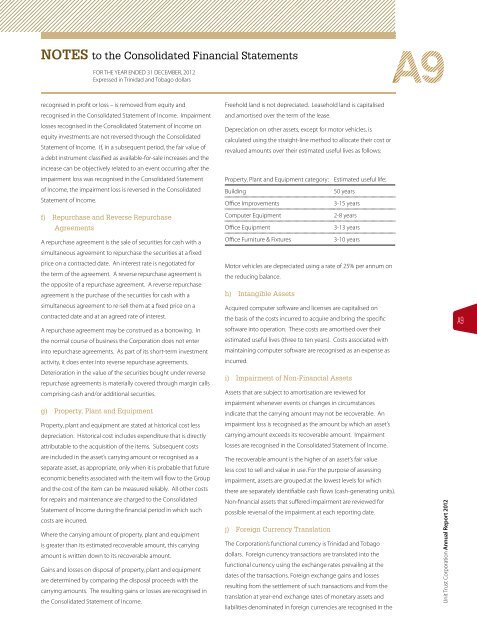p17n63qg7jmbh1r4fin71pds1p454.pdf
You also want an ePaper? Increase the reach of your titles
YUMPU automatically turns print PDFs into web optimized ePapers that Google loves.
Notes to the Consolidated Financial Statements<br />
FOR THE YEAR ENDED 31 DECEMBER, 2012<br />
Expressed in Trinidad and Tobago dollars<br />
recognised in profit or loss – is removed from equity and<br />
recognised in the Consolidated Statement of Income. Impairment<br />
losses recognised in the Consolidated Statement of Income on<br />
equity investments are not reversed through the Consolidated<br />
Statement of Income. If, in a subsequent period, the fair value of<br />
a debt instrument classified as available-for-sale increases and the<br />
increase can be objectively related to an event occurring after the<br />
impairment loss was recognised in the Consolidated Statement<br />
of Income, the impairment loss is reversed in the Consolidated<br />
Statement of Income.<br />
f) Repurchase and Reverse Repurchase<br />
agreements<br />
A repurchase agreement is the sale of securities for cash with a<br />
simultaneous agreement to repurchase the securities at a fixed<br />
price on a contracted date. An interest rate is negotiated for<br />
the term of the agreement. A reverse repurchase agreement is<br />
the opposite of a repurchase agreement. A reverse repurchase<br />
agreement is the purchase of the securities for cash with a<br />
simultaneous agreement to re-sell them at a fixed price on a<br />
contracted date and at an agreed rate of interest.<br />
A repurchase agreement may be construed as a borrowing. In<br />
the normal course of business the Corporation does not enter<br />
into repurchase agreements. As part of its short-term investment<br />
activity, it does enter into reverse repurchase agreements.<br />
Deterioration in the value of the securities bought under reverse<br />
repurchase agreements is materially covered through margin calls<br />
comprising cash and/or additional securities.<br />
g) Property, Plant and equipment<br />
Property, plant and equipment are stated at historical cost less<br />
depreciation. Historical cost includes expenditure that is directly<br />
attributable to the acquisition of the items. Subsequent costs<br />
are included in the asset’s carrying amount or recognised as a<br />
separate asset, as appropriate, only when it is probable that future<br />
economic benefits associated with the item will flow to the Group<br />
and the cost of the item can be measured reliably. All other costs<br />
for repairs and maintenance are charged to the Consolidated<br />
Statement of Income during the financial period in which such<br />
costs are incurred.<br />
Where the carrying amount of property, plant and equipment<br />
is greater than its estimated recoverable amount, this carrying<br />
amount is written down to its recoverable amount.<br />
Gains and losses on disposal of property, plant and equipment<br />
are determined by comparing the disposal proceeds with the<br />
carrying amounts. The resulting gains or losses are recognised in<br />
the Consolidated Statement of Income.<br />
Freehold land is not depreciated. Leasehold land is capitalised<br />
and amortised over the term of the lease.<br />
Depreciation on other assets, except for motor vehicles, is<br />
calculated using the straight-line method to allocate their cost or<br />
revalued amounts over their estimated useful lives as follows:<br />
Property, Plant and Equipment category: Estimated useful life:<br />
Building 50 years<br />
Office Improvements 3-15 years<br />
Computer Equipment 2-8 years<br />
Office Equipment 3-13 years<br />
Office Furniture & Fixtures 3-10 years<br />
Motor vehicles are depreciated using a rate of 25% per annum on<br />
the reducing balance.<br />
h) Intangible assets<br />
Acquired computer software and licenses are capitalised on<br />
the basis of the costs incurred to acquire and bring the specific<br />
software into operation. These costs are amortised over their<br />
estimated useful lives (three to ten years). Costs associated with<br />
maintaining computer software are recognised as an expense as<br />
incurred.<br />
i) Impairment of non-financial assets<br />
Assets that are subject to amortisation are reviewed for<br />
impairment whenever events or changes in circumstances<br />
indicate that the carrying amount may not be recoverable. An<br />
impairment loss is recognised as the amount by which an asset’s<br />
carrying amount exceeds its recoverable amount. Impairment<br />
losses are recognised in the Consolidated Statement of Income.<br />
The recoverable amount is the higher of an asset’s fair value<br />
less cost to sell and value in use. For the purpose of assessing<br />
impairment, assets are grouped at the lowest levels for which<br />
there are separately identifiable cash flows (cash-generating units).<br />
non-financial assets that suffered impairment are reviewed for<br />
possible reversal of the impairment at each reporting date.<br />
j) foreign Currency translation<br />
The Corporation’s functional currency is Trinidad and Tobago<br />
dollars. Foreign currency transactions are translated into the<br />
functional currency using the exchange rates prevailing at the<br />
dates of the transactions. Foreign exchange gains and losses<br />
resulting from the settlement of such transactions and from the<br />
translation at year-end exchange rates of monetary assets and<br />
liabilities denominated in foreign currencies are recognised in the<br />
A9<br />
Unit Trust Corporation Annual Report 2012<br />
A9



